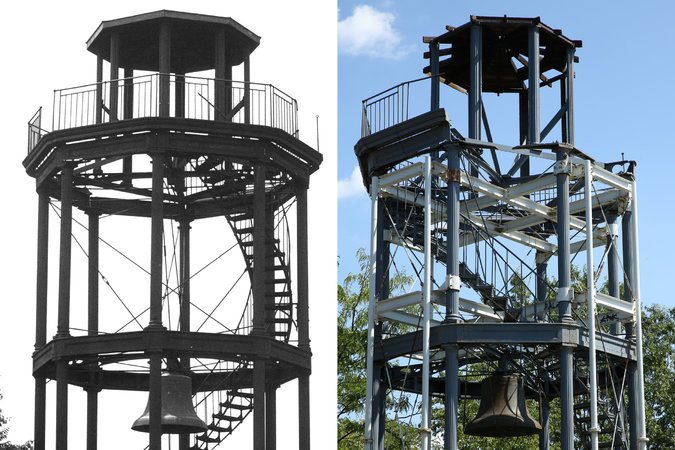David W. Dunlap reports for The New York Times: Promise Made for Harlem Watchtower’s Restoration, but Not in Ink.
Manhattan is about to lose its last antebellum watchtower.

Neighbors and preservationists are afraid it will never come back.
Before another word about the current controversy, however, let me assure a couple of astonished readers that, yes, a 19th-century watchtower still stands in Manhattan, complete with a five-ton bell, though it has not tolled a fire alarm for 136 years.
“The watchtower is an organic and visible part of Harlem,” CouncilwomanInez E. Dickens said last month, “but more than that, it is an irreplaceable New York City icon.”
In an era without alarm boxes or telephones, watchmen scanned the city from lookout towers for any sign of smoke or flame, letting fire companies know where to go by the number of bell tolls. In 1857, a 47-foot, cast-iron tower, designed by Julius B. Kroehl, was constructed atop the 70-foot Snake Hill, an otherwise unnavigable outcropping roughly where Fifth Avenue would have intersected with 122nd Street.
“The entire upper end of Manhattan Island was guarded by this tower,” The New York Times recalled in 1896. Three bells meant the fire was in Yorkville; four bells meant Bloomingdale, to the southwest; five bells meant Harlem; six bells meant Carmansville, to the northwest.
The watchtower in 1986. It was decommissioned in 1878.
The tower was decommissioned in 1878 after the advent of fire alarms. Snake Hill’s steep terrain defied development. It became Mount Morris Park, which was renamed Marcus Garvey Park in 1973. The tower was designated a landmark in 1967.
Like an octagonal cast-iron skeleton, the watchtower still rises over Harlem rooftops from a landscaped plateau called the Acropolis. It was once used as a jungle gym by neighborhood children, including Ms. Dickens, but is now fenced off.
More than 75 years have passed since it was last rehabilitated. Restoration was promised in 1986. Steel bracing was added in 1991. This fall, the parks department plans to dismantle the structure and store the components atFort Totten in Bayside, Queens. Eventually, the pieces are to be restored and returned to the park.
“The continued deterioration of its cast-iron elements and connections raises concerns that the structure is likely to be further destabilized and could collapse, especially with recent increases in major storm activities,” said Phil Abramson, a spokesman for the parks department.
It’s the storage part that has neighbors and preservationists worried, because the agency has a $2.483 million dismantling contract but has not yet signed a restoration contract.
“I am afraid that once the watchtower is dismantled, there will be no urgency to restore it,” Ms. Dickens said in an Aug. 19 letter to the parks commissioner. “Without the watchtower, the Acropolis will become more isolated from the rest of the park and a haven for more criminal activities.
The watchtower rises over Harlem on a plateau called the Acropolis. The tower was once used as a jungle gym by neighborhood children but is now fenced off.
(When my colleague Ozier Muhammad and I were visiting the Acropolis on Sept. 4, a police officer shot and wounded a man during a confrontation about 100 yards from where we stood.)
Mr. Ayón also recalled the brazen theft in 1974 of the panels from an 1848 building by James Bogardus, an inventor and designer who is widely credited with popularizing cast-iron architecture. (Mr. Bogardus designed watchtowers, too, and sued the city in 1858 for using his methods at Snake Hill without pay.) Looking for scrap to sell, thieves made off with the disassembled cast-iron panels from a vacant lot downtown in which they were being stored. Reporters were alerted when Beverly Moss Spatt, then the chairwoman of the Landmarks Preservation Commission, ran into City Hall and shouted, “Someone has stolen one of my buildings!”
But Mr. Abramson of the parks agency said the watchtower would be safe. “The storage bunkers are in a very secure part of Fort Totten and are dry, well-ventilated and outside of any potential flood areas,” he said. Because it is on city property, he said, there will be no storage bill.
Dismantling and storage will be handled by Nicholson & Galloway, a “leading preservation contracting firm,” Mr. Abramson said, and Allen Architectural Metals. Their work will be reviewed by the engineering firmThornton Tomasetti, he said, “to ensure that all precautions are taken to minimize damage.”
As for restoration, Mr. Abramson said, “we plan to discuss the proposed design with community groups and the Landmarks Preservation Commission in the summer of 2015, to be followed by putting the capital project out to bid to secure a contractor, and having the restoration work begin immediately thereafter.”
Mr. Abramson said the agency was “fully committed to ensuring that any additional funds required for the restoration are allocated.”
Peg Breen, the president of the New York Landmarks Conservancy, would like to see that commitment in writing. She noted that landmarks in Harlem were often neglected by the city. “Promises up there,” she said, “have had a hard time being kept.”





